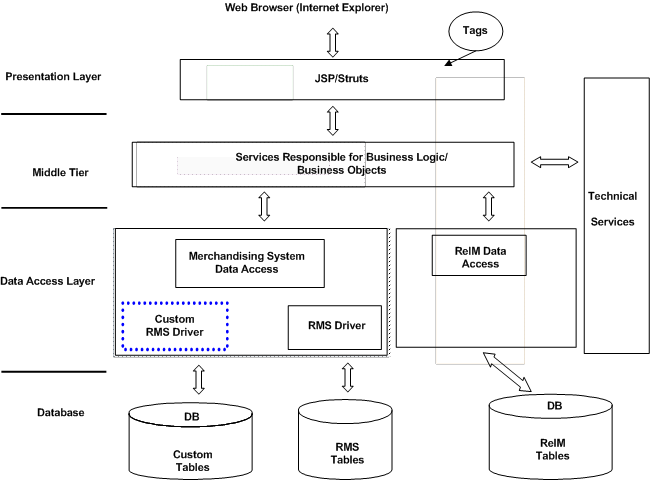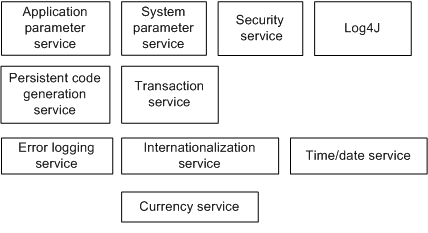| Oracle® Invoice Matching Operations Guide Release 13.2.9 E73506-01 |
|
 Previous |
 Next |
This chapter describes the overall software architecture for ReIM. The chapter provides a high-level discussion of the general structure of the system, including the various layers of Java code.
Note that at the end of this chapter, a description of ReIM-related Java terms and standards is provided for your reference.
The system's Java architecture is built upon a layering model. That is, layers of the application communicate with one another through an established hierarchy and are only able to communicate with neighboring layers.
The application is divided into a presentation layer, a middle tier consisting of services and business objects, and a database access/driver layer. Technical services offers the application frameworks for error logging, internationalization, transaction management, application security, and so on.
The segregation of layers has the following advantages, among others:
The separation of presentation, business logic, and data makes the software cleaner, more maintainable, and easier to modify.
The look and feel of the application can be updated more easily because the GUI is not tightly coupled to the back end.
A layered architecture has become an industry standard.
Portions of the data access layer (DAL) can be radically changed without effecting business logic or user interface code.
The application takes advantage of Java database connectivity (JDBC), minimizing the number of interface points that must be maintained.
Market-proven and industry-standard technology is utilized (for example, JSPs, JDBC, and so on).
The following diagram offers a high-level conceptual view of the layers and their responsibilities within the architecture. Key areas of the diagram are described in more detail in the sections that follow the diagram.

This area of the architecture encapsulates the graphical user interface (GUI) processing. A web browser accesses JSP pages using a Struts tag library.
JSPs consist of JavaScript and standard HTML. They make calls to tag-libraries. Extensions of Java servlet technology, JSPs are compiled into servlets. JSPs provide a user interface that can be separated from most of the business logic that resides on the server. This separation of presentation from content offers a greater possibility for ease of maintenance, both with regard to the page that the user sees and the underlying logic. The look and feel of the GUI is easy to customize, and dynamic functionality is easy to create.
Struts provide an open source framework for building Web applications. The core of Struts is a flexible control layer based upon Java servlets, JavaBeans, ResourceBundles, and Extensible Markup Language (XML). Struts provide an industry standard approach to enforcing the division between user interface code and business logic. Struts also provide standard functionality for error display, internationalization/screen translation, and so on. The Struts framework is part of the Jakarta Project, sponsored by the Apache Software Foundation (http://www.apache.org/). The official Struts home page is http://jakarta.apache.org/struts.
The presentation layer interacts only with the middle tier services.
The middle tier comprises the service layer responsible for business logic and Busines Objects.
The service layer consists of a collection of Java classes that implement business logic (data retrieval, updates, deletions, and so on) through one or more high-level methods. In other words, the service layer controls the workflow. For example, when a user clicks OK on a page, the server must follow a given series of steps to accomplish business functionality. The service layer controls how those steps are accomplished.
The service layer is the entry point to the middle tier and separates the presentation layer from the database layer. Generally the methods that are exposed by service layer classes accept and/or return business objects. The service layer encapsulates the business logic by calling down into business objects and the data access layer, thus making the code more maintainable.
Within ReIM, business objects are beans (that is, Java classes that have one or more attributes and corresponding set/get methods) that represent a functional entity. In other words, business objects can be thought of as data containers, which by themselves have almost no business functionality. (In those unusual cases where business logic resides within a business object, the logic pertains to a discreet business concept.) Two examples of business objects include Document and Supplier.
There is not necessarily a one-to-one relationship between a business object and a database table. The service layer may utilize more than one class from the data access layer in order to combine the data from more than one database table to fully populate a business object.
The data access layer interacts only with the middle tier and the database. Classes in the DAL abstract the actual persistence mechanism that is being used to persist business objects. The DAL provides the mechanism that allows ReIM to be associated to a different persistence engine. Ideally, in those cases, only the DAL would need to be modified due to the change. The remainder of ReIM would continue to operate unchanged.
The ReIM DAL consists of two very distinct portions: a DAL to ReIM owned tables and an interface DAL to merchandising system tables. The two distinct types of Java code are described below.
The database layer is the application's storage platform, containing the physical data (user and system) used throughout the application. This layer is only intended to deal with the storage and retrieval of information and is not involved in the manipulation of the data.
To increase the maintainability of the code, and enhance the rapid development of new business logic, a number of base technical services are provided.
Technical services include application frameworks such as error logging, internationalization, transaction management, application security, and so on.
A brief description of each technical service follows the diagram.

This service allows application configuration parameters to be stored within the database on a single database table. Developers can retrieve these parameters using a high level interface.
Similar to the application parameter service, this service is used only for technical configuration parameters. Although most configurable parameters are hosted in a system parameter table, some parameters are located in a properties file. See Chapter 2, "Backend System Administration and Configuration," for information.
|
Note: The transaction service does not provide checkpoint transaction management or multi-phase commit. |
This service provides a simplified management of rollback/commit semantics. In order to avoid the need to pass the database connection between the middle tier method calls and the data access layer classes, the transaction service uses thread local variables to maintain the current connection for a thread until that thread has committed or rolled back the transaction. This service thus simplifies transaction management.
This service incorporates a standard ReIMException class to raise and handle Java exceptions (shown below). The ReIMException class automatically logs itself to the application log file. The level of logging may be raised or lowered in the properties file. For example, an operator could configure the system to only display INFO and above. See Chapter 2, "Backend System Administration and Configuration," for information.
The system's coding pattern ensures that the error messages, no matter where they originate, remain detailed in their presentation to the operator.
This service provides the error logging services with a standard method for logging information to a flat text file. Log4J is an open source product.
This service uses resource files to provide configurability for on-screen messages (such as on screen labels or error messages). To change the language for the ReIM GUI screens, a replacement set of resource files can be created. Note that although this service supports any number of languages, the screen flow remains left to right, top to bottom.
This service provides a high-level mechanism for developers to represent a currency amount. This service provides the formatted representation of that currency.
This service provides a high level interface to the Java time/date constructs along with some formatting methods for displaying these constructs on the GUI screens.
The security service provides basic authorization and authentication functionality during user logon. The association of the user to security roles controls user access to the functional areas of the application. The security service validates a user's identity against a security store and retrieves the role memberships and role authorizations for that user upon a successful logon. The physical implementation of the security information for each user, role, functional authorizations, and field authorizations is independently configurable among LDAP server locations.
ReIM is deployed using the technologies and versions described in this section.
The Java 2 Enterprise Edition (J2EE)
The Java standard infrastructure for developing and deploying multi-tier applications. Implementations of J2EE provide enterprise-level infrastructure tools that enable such important features as database access, client-server connectivity, distributed transaction management, and security.
Java Database Connection (JDBC)
JDBC is a means for Java-architected applications such as ReIM to execute SQL statements against an SQL-compliant database, such as Oracle. JDBC is part of Sun J2EE specification. Most database vendors implement this specification.
JDBC provides the support that allows ReIM to submit SQL queries to the database and receive the result set for further processing.
Java Development Kit (JDK)
Standard Java development tools from Sun Microsystems.
Java Server Pages (JSP)
JSPs enable Java and HTML to be combined within a web page. To the user, a JSP appears in the Web browser as a file with a .jsp extension. The JSP source is dynamically compiled into a servlet by the servlet container running in the web server. The servlet generates the necessary HTML content that the user sees.
Java Servlet
A servlet is a Java platform technology that allows a web application easier access to server side resources. The HTTP request from the client's browser is routed to the servlet, which then can process it as necessary and provide the applicable response to the user.
LOG4J
LOG4J is an open source sub-project of the Jakarta Project. It provides a configurable framework for logging information gathered during the execution of an application.
Naming Conventions in Java
Packages: The prefix of a unique package name is written in all-lowercase letters.
Classes: These descriptive names are unabbreviated nouns that have both lower and upper case letters. The first letter of each internal word is capitalized.
Interfaces: These descriptive names are unabbreviated nouns that have both lower and upper case letters. The first letter of each internal word is capitalized.
Methods: Methods begin with a lowercased verb. The first letter of each internal word is capitalized.
Struts
An open source web development framework from the Jakarta Project and sponsored by the Apache Foundation. The framework includes three major components:
A controller servlet that dispatches requests to applicable ReIM Action classes.
JSP custom tag libraries, and associated support in the controller servlet, that support ReIM in providing an interactive form-based application.
Utility classes to support the following:
XML parsing
The automatic population of JavaBeans properties based on the Java reflection APIs
The internationalization of prompts and messages